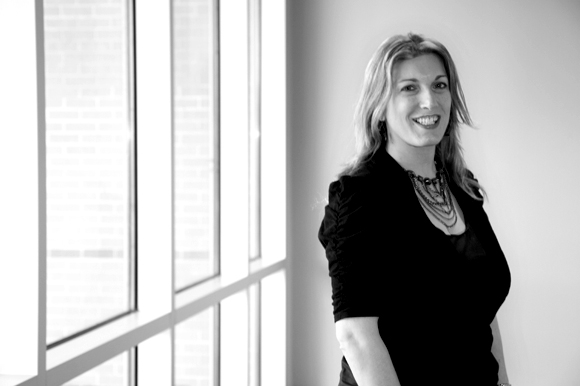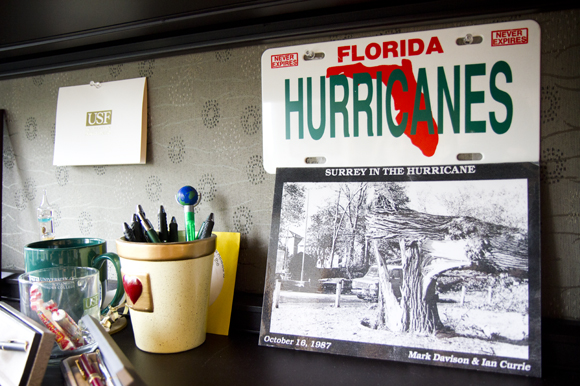USF Professor Eyes Global Weather To Predict Hurricanes
June 1st marked the official start of the six-months-long hurricane season, prompting some Floridians to start stocking up on supplies and tuning into weather reports. But for one USF Tampa scientist, hurricanes and tropical storms aren't a cause of anxiety; they're a source of endless fascination and a focus of her career.
Dramatic storms seem to be popping up with greater frequency around the globe. Think just of the number of deadly hurricanes hitting the U.S. in the last decade, giant storms like Hurricane Katrina devastating places like New Orleans and the string of deadly tornados in the Midwest and South, both in 2011 and earlier this year. What’s going on?
Climate scientists like USF Tampa’s Jennifer Collins, Ph.D., are driven to find answers.
An associate professor in USF’s Department of Geography, Environment and Planning, Collins analyzes weather patterns all over the world, from the Pacific and Atlantic Oceans to South America and Africa.
She just completed a detailed month-by-month examination of activity in the Atlantic and Pacific Oceans, looking at factors that might influence the strength or weakness of the hurricane season.
“I’m trying to understand this huge phenomenon that we call a hurricane, which can affect so many lives,” says Collins. “The more we understand the causes and why the season varies from year to year, the more we can be in a position to predict them with greater accuracy.”
Collins is credited with pioneering research that demonstrates when the Eastern North Pacific Ocean is subdivided into two developmental regions — East and West, the western region near Hawaii has an inverse relationship on storms looming in the North Atlantic.
What’s the significance? “An active storm season in the western region of the Eastern North Pacific usually translates to a quieter season in the North Atlantic,” says Collins.
Because the Eastern North Pacific storm season begins slightly earlier than the Atlantic, we might be able to examine activity in one area to predict what will occur in the other, says Collins.
More work needs to be done to validate her discovery, she says, but in the future it might be a useful tool that could offer a long lead-time for emergency planning. For example, a quiet season in the Eastern North Pacific might signal the possibility of potentially dangerous storm activity in the Atlantic that could put the East Coast of the U.S. at risk.
With the official hurricane season already underway this summer, does Collins have any predictions? She says she doesn’t put much faith in predictions, primarily because she’s concerned about how the public interprets and reacts to the data.
“I never want to lull people into a false sense of security,” says Collins. “There is still much to be learned about what causes year-to-year fluctuations before such seasonal forecasts can be more accurate and effective.”
As an example, she points to the 1992 season, which was supposed to be quiet. There were only six named storms, but the first of that season was Hurricane Andrew, which pounded South Florida, flattening Homestead, Florida City and parts of Miami.
In addition to developing better methods of understanding and predicting hurricanes, Collins and her team recently completed a study that identifies groups of people who are particularly vulnerable during a bad storm.
A new prototype web application allows emergency managers to quickly identify socially vulnerable populations who might need additional resources or help evacuating.
“We’ve pulled in key census data, such as whether they live in rental housing, their age, race, poverty level and similar factors and used that to form a social vulnerability profile,” says Collins.
The social vulnerability data is then overlaid with warnings, watches or advisories from the National Weather Service and information about hazards such as risk of tornadoes, flooding, potential for storm surge and damaging winds in the location where the population lives. Together, this creates a complete picture or total vulnerability profile, says Collins.
Collins, who grew up in the United Kingdom, says the pivotal storm that changed her life was the “Great Storm of 1987.” On the day, she was planning a big party to celebrate her 12th-birthday, hurricane-force winds hit southern England and northern France. Not since 1703 had such destructive weather struck that part of the world.
The storm wrecked her 12th-birthday party. It also stirred up a life-long interest in hurricanes. She came to USF in 2005, drawn in part by the four hurricanes in a row that shook up Florida in 2004.
Now, in addition to teaching undergraduate and graduate level classes such as Meteorology, Climatology and Weather, Climate, and Society, Collins oversees the USF Weather Center and conducts ground-breaking storm research.
Janan Talafer is a freelance writer in St. Petersburg, FL, who shares a home office with her dog Bear and two cats Milo and Nigel. Comments? Contact 83 Degrees.

















